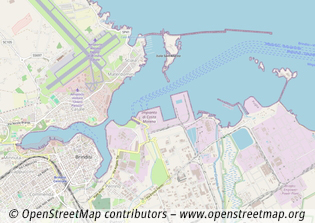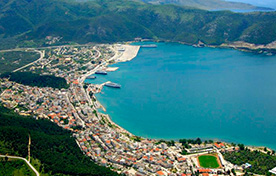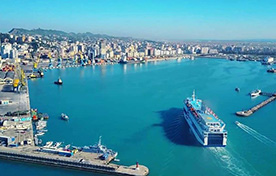
The Map Data comes from OpenStreetMap contributors. It is available under the Open Database License (ODbL) .
Brindisi: Your Adriatic Gateway to Puglia's Charms
Nestled on the stunning Adriatic coast of Southern Italy, Brindisi is more than just a bustling port city; it's a destination steeped in history, brimming with Mediterranean culture, and the perfect starting point for exploring the sun-kissed region of Puglia. Often recognized as a crucial transit hub, particularly for ferries connecting Italy with Greece and Albania, Brindisi invites travellers to look beyond its harbour and discover the treasures hidden within its ancient streets, scenic coastline, and vibrant local life. Whether you're arriving by ferry from Igoumenitsa or Vlore, flying into Salento Airport, or driving down the Italian boot, Brindisi offers a warm Puglian welcome. This guide provides all the tourist information for Brindisi you need to plan your visit.
Where Exactly is Brindisi?
Brindisi holds a strategic position on the southeastern coast of Italy, within the region of Puglia (Apulia in English). It serves as the capital of the province of the same name. Situated on the "heel" of Italy's boot, specifically on the Salento peninsula, Brindisi boasts a natural harbour that has been strategically important since antiquity. Its location on the Adriatic Sea makes it a natural bridge between Italy and the eastern Mediterranean, cementing its role as a vital ferry port. It lies roughly 115 kilometres southeast of Bari and about 40 kilometres north of Lecce, another gem of the Salento region.
Echoes of Antiquity: Brindisi's Rich History and Archaeological Sites
Brindisi's history is long and fascinating, deeply intertwined with the sea. Legend attributes its founding to the mythical hero Diomedes, but historical evidence points to ancient Messapian origins before it became a significant Roman centre.
The Roman Legacy: Perhaps Brindisi's most defining historical role was as a major Roman port. It marked the terminus of the famous Via Appia (Appian Way), the ancient Roman road connecting the city directly to Rome. This strategic importance made Brindisi a key military and commercial harbour. Visitors can still see the symbolic end of this road marked by the imposing Colonne Romane (Roman Columns). Although only one column stands fully erect today (the other collapsed in the 16th century, its base remains), these marble sentinels overlooking the inner harbour are powerful reminders of Brindisi's Roman grandeur. Near the columns, you can often find excavations revealing parts of the ancient road itself.
Archaeological Museum (Museo Archeologico Provinciale Francesco Ribezzo): To delve deeper into Brindisi's past, a visit to this museum is essential. Housed in a beautiful building near the cathedral square, it showcases artefacts from the prehistoric, Messapian, Roman, and medieval periods. Highlights include impressive bronze sculptures recovered from the sea at Punta del Serrone, Attic vases, and Roman epigraphs.
San Giovanni al Sepolcro Temple: This unique circular church, dating back to the 11th or 12th century, is a must-see. Built by the Normans, possibly Templars, its architecture evokes the Church of the Holy Sepulchre in Jerusalem. Its evocative atmosphere and well-preserved frescoes offer a glimpse into the city's medieval religious life.
Archaeological Area of San Pietro degli Schiavoni: Located beneath the Nuovo Teatro Verdi, this site reveals layers of Roman Brindisi, including mosaics, thermal baths, and parts of ancient dwellings (insulae). It offers a fascinating underground perspective of the city's layout during Roman times.
While not as concentrated as Rome, Brindisi offers significant archaeological points of interest that paint a vivid picture of its importance through the ages.
Exploring Brindisi: Top Attractions and Things to Do
Beyond its historical sites, Brindisi offers a pleasant blend of coastal charm and urban life.
Lungomare Regina Margherita: The city's beautiful waterfront promenade is the heart of Brindisi's social life. Perfect for a leisurely stroll (the classic Italian passeggiata), it's lined with palm trees, cafes, restaurants, and gelaterias. Enjoy views of the inner harbour, watch boats come and go, and soak up the Mediterranean atmosphere. The Virgil's Staircase, leading up to the Roman Columns, connects the harbour with the older part of the city.
Castello Svevo (Swabian Castle): Also known as Castello Grande or Castello di Terra, this imposing fortress was built by Emperor Frederick II in the 13th century. Located near the city centre, it overlooks the western arm of the harbour. Although primarily used by the military, its impressive structure is a key feature of the city's skyline and history.
Castello Alfonsino (Aragonese Castle): Situated on the small island of Sant'Andrea at the entrance to the outer harbour, this castle is often called Castello di Mare (Sea Castle). Built in the 15th century by Alfonso V of Aragon, its picturesque setting guarding the harbour entrance is striking. While access can sometimes be restricted, viewing it from the sea (perhaps as your ferry to Brindisi arrives or departs) or from specific points on the coast is worthwhile.
Duomo di Brindisi (Cathedral of the Visitation and Saint John the Baptist): Located in the charming Piazza Duomo, the city's cathedral was originally built in the Romanesque style in the 11th-12th centuries, though it was largely rebuilt after an earthquake in 1743. It retains fragments of its original mosaic floor and houses the relics of Saint Theodore of Amasea, one of Brindisi's patron saints. The adjacent Seminary Palace and Portico of the Templars add to the square's historical ambience.
Chiesa di Santa Maria del Casale: Located just outside the city centre, near the airport, this stunning church is a jewel of Gothic-Romanesque architecture from the late 13th century. Its distinctive facade with geometric patterns and beautiful interior frescoes make it a significant artistic landmark.
Sun, Sand, and Sea: Beaches Near Brindisi
While Brindisi itself is primarily a port city, beautiful beaches are just a short drive away, perfect for escaping the summer heat.
Punta Penne Grossa Beach: North of the city, this long sandy beach is part of the Torre Guaceto Nature Reserve. It offers clear waters and natural dunes, making it popular with families and nature lovers.
Torre Guaceto Nature Reserve: This protected marine and coastal area is a haven for biodiversity. Besides beautiful beaches like Punta Penne Grossa and Spiaggia delle Conchiglie, it offers opportunities for snorkelling, bird watching, and cycling through pristine Mediterranean maquis shrubland. Access to some core areas is regulated to protect the environment.
Lido Azzurro: Closer to the city, this is a well-equipped beach resort offering amenities like sunbeds, umbrellas, and cafes.
Apani Beach: Another option north of Brindisi, known for its sandy stretches and relatively calm waters.
Exploring the coastline north and south of Brindisi reveals numerous coves and larger beaches characteristic of the beautiful Salento region.
A Taste of Puglia: Food and Drink in Brindisi
Puglian cuisine is renowned for its fresh, simple, and delicious flavours, heavily based on local produce, seafood, and excellent olive oil. Brindisi offers ample opportunities to indulge.
Orecchiette: The signature pasta shape of Puglia, resembling "little ears." Often served with cime di rapa (turnip greens) or a rich tomato sauce.
Seafood: Given its coastal location, fresh fish and shellfish are staples. Look for grilled octopus (polpo alla griglia), mussels (cozze), sea bream (orata), and sea bass (spigola). Fritto misto di mare (mixed fried seafood) is a popular treat.
Olive Oil: Puglia is Italy's largest producer of olive oil, and Brindisi is no exception. Expect high-quality extra virgin olive oil to feature heavily in local dishes.
Cheeses: Burrata (creamy mozzarella) and cacioricotta (a semi-hard cheese) are local favourites.
Vegetables: Abundant sunshine means flavourful vegetables like tomatoes, aubergines (eggplant), artichokes, and peppers are widely used. Melanzane ripiene (stuffed aubergines) is a common dish.
Wine: The Salento region produces excellent wines. Try robust reds like Negroamaro and Primitivo (genetically related to Zinfandel) or refreshing rosé wines (rosato).
Street Food: Don't miss rustico Leccese (a puff pastry filled with béchamel, mozzarella, and tomato, originating from nearby Lecce but popular in Brindisi) or panzerotti (fried dough pockets filled with tomato and mozzarella).
Dining options range from traditional trattorias in the old town to seafood restaurants along the Lungomare.
Evening Entertainment and Nightlife
Brindisi's entertainment scene is relaxed and centres around its waterfront and historic centre.
Passeggiata: The evening stroll along the Lungomare Regina Margherita is a cherished local tradition. Join the locals for a walk, stop for an aperitivo (pre-dinner drink with snacks) at one of the many bars, and enjoy the sea breeze.
Bars and Cafes: Numerous bars and cafes, particularly along the harbour and in the main squares like Piazza della Vittoria, offer places to relax with a coffee, wine, or cocktail.
Restaurants: Enjoy long, leisurely dinners at the city's restaurants, sampling local cuisine and wines. Many establishments offer outdoor seating in warmer months.
Events and Festivals: Check local listings for seasonal events, concerts, or festivals (sagre) celebrating local food or traditions, which can add extra vibrancy to your visit.
While not a wild party town, Brindisi offers a pleasant and sociable evening atmosphere, perfect for unwinding after a day of exploring or travelling.
Where to Stay: Accommodation in Brindisi
Brindisi offers a range of accommodation options to suit different budgets and preferences.
Hotels: You'll find several hotels, from larger establishments near the port and train station offering convenience for travellers, to more boutique options in or near the historic centre. Look for hotels along the main Corso Garibaldi or near the Lungomare for easy access to sights and dining.
B&Bs and Guesthouses: Bed and Breakfasts (affittacamere) are increasingly popular, often located in historic buildings and offering a more personal touch and local experience. Many are situated within the charming streets of the old town.
Apartments: Self-catering apartments can be a good option for longer stays or families, providing more space and flexibility.
Consider staying near the harbour or the historic centre for the best atmosphere and convenience for exploring the main attractions on foot.
Essential Information for Visitors
Emergency Number: The single European emergency number is 112. This covers police, ambulance, and fire services.
Tourist Information: Look for local tourist information points (often signed as Ufficio Turistico or Pro Loco) for maps, brochures, and specific queries.
Port Authority (Autorità Portuale): While you likely won't need to call them directly as a passenger, their presence underscores the port's importance. Ferry company offices at the port handle passenger inquiries.
Getting Around: Brindisi's city centre is quite walkable. Local buses (STP Brindisi) connect the centre with the airport, train station, port areas, and suburbs. Taxis are also available.
How to Reach Brindisi: Your Travel Options
Brindisi is well-connected by sea, air, rail, and road.
By Ferry: This is arguably one of the most scenic and convenient ways to arrive, especially from Greece or Albania. The Port of Brindisi is a major hub for ferries to and from Igoumenitsa (mainland Greece) and Vlora (Albania). Several ferry companies operate these routes, offering daily or frequent sailings, particularly during peak season. Crossing times vary, but the overnight journey from Greece is popular. Arriving by sea offers stunning views of the Alfonsino Castle guarding the harbour entrance. Booking your Brindisi ferry tickets in advance, especially during summer, is highly recommended – platforms like ferries.gr make this process easy and efficient. Ferry connections might also exist seasonally to Greek islands like Corfu and Zakynthos.
By Air: Brindisi Airport (BDS), also known as Salento Airport, is located just a few kilometres north of the city centre. It handles domestic flights from major Italian cities (Rome, Milan, Venice, etc.) and numerous international flights, including many seasonal routes from across Europe operated by budget and flag carriers. A shuttle bus connects the airport directly to the city centre and the port.
By Train: Brindisi's train station is centrally located and offers connections via Trenitalia (Italy's national railway) to major cities like Lecce, Bari, Naples, and Rome (including high-speed options). Train travel is an efficient way to explore other parts of Puglia and Italy.
By Car: Brindisi is accessible via major highways. The SS16 (E55) runs along the Adriatic coast connecting Bari and Lecce via Brindisi. The SS7 (Via Appia Nuova) connects Brindisi towards Taranto and eventually Rome, loosely following the path of the ancient road. Driving allows flexibility for exploring the surrounding Salento region.
The Port of Brindisi: Gateway to the Adriatic
The Porto di Brindisi is the city's lifeblood and a critical piece of infrastructure for tourism and trade in the Southern Adriatic.
Structure: The port consists of an outer harbour, protected by the mainland and the Pedagne islands (including Sant'Andrea where Castello Alfonsino sits), and a Y-shaped inner harbour that penetrates the city itself, offering natural protection.
Passenger Terminals: Ferry operations primarily use the Costa Morena area, slightly north of the city centre. This area houses dedicated passenger terminals with check-in desks for various ferry companies, waiting areas, customs, and some basic facilities. Shuttle buses often connect the passenger terminals with the city centre and train station. Always check your booking details for the specific terminal and check-in procedures for your ferry operator.
Ferry Routes: The main international routes connect Brindisi with:
- Igoumenitsa (Greece): This is the primary and busiest ferry route, offering multiple daily sailings year-round. It's the quickest sea link between Italy and Western Greece.
- Vlore (Albania): Frequent connections link Brindisi with Albania.
- Corfu & Zakynthos (Greece): Seasonal ferry routes often operate during the summer months, connecting Brindisi directly with these popular Ionian Islands.
The website www.Ferries.gr is the perfect way to find information on all ferry routes from / To Brindisi. You can search for routes based on the date of departure and destination, and learn about all the companies that depart and the prices of tickets.











